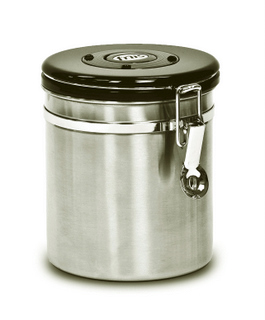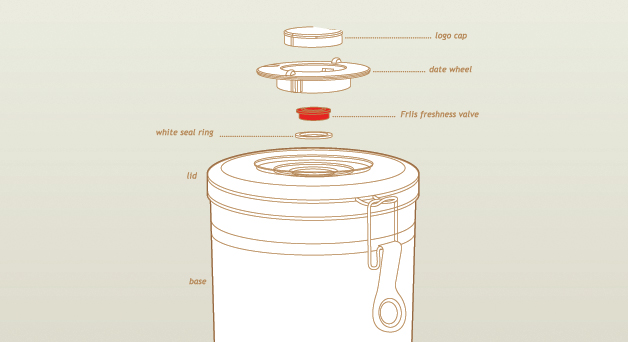As anyone who reads this site regularly already knows, I like coffee. I wouldn’t go so far as to say I’m a snob, but I know what I like. If you serve me swill I’ll drink it, but i don’t have to like it. I recognize both goof coffee, and equipment which allows for the production of good coffee. Today I’m lucky enough to talk about the Friis Coffee Savor. Friis, pronounced “Freece” was kind enough to send me a model to try out and report my finding on. The claim is that this canister will allow Carbon Dioxide out of the can, while not allowing Oxygen in, and by doing this keep coffee fresh longer. And anything that keeps Coffee fresh is alright in my book. Come with me as we test this neat idea out.

The Claims:
I like simple and easily provable claims to judge products on. Most companies that make simple statements don’t have anything to hide, which is what I like. Cut the buzzwords give me the facts.
- Claim #1: Prevents a buildup of Carbon Dioxide inside the canister
- Claim #2: Keeps Coffee at peak freshness for longer than traditional storage
Simple claims and a very thirsty reviewer make for an easy review to write.
Whats Inside:
 Inside the package you will get the following
Inside the package you will get the following
- One Friis Coffee Savor Canister.
- Six replacement filters, equivalent of a 12 month supply of filters.
- A Registration card with offer for more filters.
- A measuring spoon
- The Art of Flavor, a guide to better tasting coffee
How it works:
 Grab a lab coat, we’re gonna go a Mr Wizard on your here. The Friis Coffee Savor is a normal food grade stainless steel canister, albeit very well constructed, with one very important and major difference. The lid of the canister has a removable filter. This filter is designed to allow Carbon dioxide and oxygen to flow one way through it. This allows excess gasses to be removed while keeping the container in an oxygen poor environment. Oxygen leads to degradation of the coffee bean’s flavor profile through oxidation.
Grab a lab coat, we’re gonna go a Mr Wizard on your here. The Friis Coffee Savor is a normal food grade stainless steel canister, albeit very well constructed, with one very important and major difference. The lid of the canister has a removable filter. This filter is designed to allow Carbon dioxide and oxygen to flow one way through it. This allows excess gasses to be removed while keeping the container in an oxygen poor environment. Oxygen leads to degradation of the coffee bean’s flavor profile through oxidation.
Coffee, when roasted, produces Carbon Dioxide. In fact directly after roasting most guides warn you again and again not to keep the beans in an enclosed container, but rather to leave it open for anywhere from 24-36 hours. This is to allow the beans to de-gas (Unlike degaussing no magnets needed) if you close them up right after you run the risk on ruining your coffee, flattening the taste. Anytime after this initial period the carbon dioxide creation slows down. Unlike oxygen an environment rich in CO2 is not bad for coffee, but an over abundance of it can permeate the beans and flatten the flavor profile as well.
By placing the coffee into the canister the carbon dioxide produced by the beans slowly replaces the oxygen in the canister. Carbon Dioxide being heavier than air lies low in the can pushing the Oxygen rich air out the filter at the top, any overabundance of Carbon dioxide s also pushed out the filter. Since pressurized systems strive for equality, don’t we all, the carbon dioxide never gets thick enough to permeate the beans, while the oxygen won’t flow back in for the same reason. An Anaerobic environment means the beans stay fresh longer. Which is good
Still with us? Good.
Performance:
The one problem with trying to work a claim like this is that I’m going to have to ruin some coffee, and that is unacceptable, normally. So I set up two tests to run over a period of time. test 1 involves store brand espresso whole beans in two containers, step two involves roasting a batch of coffee and sealing it up tight right after.
Why espresso?
The portion size is small enough that i don’t have to brew a whole pot to check it. I don’t necessarily have the finest pallet in the world but I can get by. I should probably go to a cupping to figure the correct way to do this up right in the future.
Test 1: So here is the setup. I bought 1 pound of store brand espresso blend – whole beans and put half in the container and kept half in the bag. Tasting both of them right out of the gate they were as expected coffee was drinkable, but not fantastic. After about a week I tried a sample of espresso from both. The bagged coffee tasted a bit flat but the Friis was still pretty fresh.
After two weeks the bagged coffee had descended into stale while the Friis contained coffee still had a bit of life in it. At a Month ou, which coffee in my house never usually reaches that ripe old age, the coffee’s both tasted flat and stale. At which point i promptly composted the rest of the beans, from both batches.
Winner Friis!
I have no way of knowing when the coffee from the supermarket was roasted so it could have been fresh or last months leftovers, but the taste profiles of each blend separated after the first week of storage.
Test 2: After roasting coffee if you were to seal the coffee in an airtight container directly afterwards the beans taste much flatter and you notice a buildup of gas trapped inside the container. So I did what any self respecting home roaster would do. I roasted a nice blend of Sumatran and Colombian and dropped it directly into the container and waited 4 days. The waiting is the hardest part with this review. I had already sunk a month into the previous test this one would hopefully turn nice results and I could share with all of you fine folks.
Ater 4 days I opened the container and notice that there was no pop to the top of the container signifying trapped gas or flatted smell of coffee, rather the batch seemed nice and fresh and i had a fantastic espresso to celebrate a product that worked as advertised.
Claims:
The Friis Coffee Savor claims were accurate concerning both claims.
Cost:
The unit i received would retail for 21.95, it comes with 12 months of replacement filters. For a nice kitchen canister this is a bit high, but for a filtered coffee container it seems about right. There is also a model for 24.95.
With a situation like this you would expect to pay through the nose for replacement filters. Most of us by now are used to the “ink-jet printer model” pay for the replace-ables. However Friis is bucking this trend and basically giving them away you only have to pay for shipping. 5 dollars and you get enough filters for a year, if that’s the only thing you’re paying for is the box and the postage. I can’t thank the company enough for this!
Note: While researching this product I did find one other product which does something very similar Sweet Maria’s has a Coffee tin with a non replaceable de-gas valve, This item sells for $4.65 and has a limited lifetime. However the container is designed wrong. The valve is in the bottom fo the container, carbon dioxide is heavier than air, in order for the system to work the valve needs to be on the top to force the lighter oxidized air out.
Conclusion:
The Friis Coffee Savor is a fantastic product for people who tend to enjoy coffee over the long term. As someone who tends to blow through coffee ata good clip this may or may not make the difference in how you enjoy your beverages. It also makes a great purchase for the ardent home roaster. Overall I’m quite happy about being able to take a look at this piece and run it through its paces. More often than not a company makes the unit they are selling shoddy, and the replaceables overly expensive. Friis has gone the extra mile to make a well constructed piece of hardware and they decided to offer the replaceables at a very low and affordable cost. I can’t help but recommend their product.
:: Disclosure I was sent the Friis Coffee Savor for the purpose of reviewing it ::


Very Interesting & To Think I Was In The Development Stages Of Trying To Design The Very Same Thing. :D Hopefully My Next Idea, I Will Be Able To Incorporate It c|_| Happy CoffeeING !!
Thank you for this comprehensive review. I sell lots of Friis coffee vaults in Australia even it’s more expensive down-under and have excellent feedback from my customers.
Hi Paul:
Do you know how CO2 actually harms coffee? Is the trick here simply keeping out O2?